数字骨库系统在骨肿瘤治疗异体骨选配中的应用
2015-05-07 文章来源:第四军医大学西京医院 我要说
第四军医大学西京医院骨肿瘤科郭征主任率领团队创建国内首家数字化骨库,用数字化技术辅助骨库管理,实现异体骨的快速、精确选配,提高骨肿瘤切除后骨缺损重建的治疗效果。通讯作者为郭征教授
Introduction
Considering durability of megaprosthesis and increasing survivorship of patients with sarcoma, emphasis hasbeen placed on biologic reconstruction with allograft and xenograft especiallyin young and physically active patients in the past decades [1, 2]. Despite the associated disadvantagesincluding possible disease transmission and slow incorporation into the host bone,allograft provides an immediate structural support for osseous defect afterbone tumor resection. In addition, host ligaments and muscles can bere-attached to the allograft to restore dynamic stability [3-6]. Furthermore, long-term follow-upstudies support the use of allograft instead of metallic implant since it maybe progressively incorporated by the host bone [7, 8].
Compared to the host bone, the allograftof same anatomic site has similar mechanical and osteoconductive properties. Ithas been used to replace the tumor-affected bone at the same site withacceptable results in osteoarticular, transepiphyseal, and intercalaryreconstructions [9, 10].Selection of the closest anatomical match between host and donor is of greatimportance. A poor anatomical matching can lead to bony malalignment,osteoarticular fracture, joint degeneration, and delayed union or nonunion [11]. Therefore, size and shapedetermination is critical to obtain an appropriate allograft.
However, selection of a suitableallograft remains a major challenge. At early stage of development, selectionwas conducted by manually comparing X-ray images between donors and patient. Sometimes,even manual measurement was performed directly on the bones present in bonebank. Such a manual approach is rather subjective, time-consuming, andinaccurate [12]. With the improvement of medicalimaging technology, CT scan was introduced to measure anatomical parameters on2-D image slices [13].Although this technique refined the selection methods, the allograft still couldnot be measured and compared in 3-D space. The selection of allograft,especially the ends of long bone (osteoarticular and transepiphyseal portion)with irregular morphology remained a tough problem. In the last two decades,the virtual scenarios and computer assisted surgical techniques have beenincreasingly applied and showed promising results in clinical therapies. 3-D virtualmodels of allografts and affected bones can both be reconstructed from imagedata. Then, anatomical matching between the host and allografts can possibly beconducted, which facilitates a more accurate selection.
In this study, we established a virtual bonebank system capable of managing, analyzing, and selecting allograft through 3-Dvirtual model. The selected allografts were then used to fill the osseousdefects after tumor excisions in 14 patients with the help of computer assistedoperation system (CAOS). The objective of this study was: 1) to describe theworkflow of this technique; 2) to explain how to choose the most suitable allograftin this system; 3) to show the middle-term follow-up results of patients with transplantationof allograft selected from this virtual bone bank system.
Patients and methods
Image acquisition, segmentationand reconstruction
The bone bank of our hospital had massivebone allografts including scapula, clavicle, humerus, ulna, radius, pelvis,femur, tibia, fibula and calcaneus. Firstly, all allografts were scanned by computertomography (CT) (Mutislice 64, GE Healthcre, USA). Magnified slices with 0.625 mmthickness were obtained using a soft tissue standard filter (a matrix of 512×512 pixels) and stored in digital imaging and communication in medicine (DICOM)format. The process of image segmentation was conducted using the Mimicssoftware (Leuven, Belgium). The bone was isolated from other tissues andstructures such as muscle, fat, skin and metal table of CT scanner (Fig.1). Pseudo color image was applied onDICOM image pixel data and segmented images were used to reconstruct 3-D model(Fig.2). Because the tumor usually destroyedthe normal anatomical structure of affected limbs, 3-D tumor model appeared tobe incomplete. It was not suitable for allograft selection. Under thiscondition, the images of contralateral site were used to create 3-D mirrormodel for allograft matching. All DICOM images of each allograft were saved andreconstructed to establish a virtual bone bank system.

Figure1: (A) CT scanning of allograft; (B, C) Image acquirement and pseudo color application;(D) Image segmentation and 3-D model reconstruction.

Figure2: Establishment of visual bone bank. 3-D allograft model of proximal femur(A), tibia (B), distal femur (C), and top view of tibial plateau (D).
Comparison and selectionof allograft
In the virtual bone bank system, 3-D tumormodel and allograft were measured and compared to determine the best match. Thevolume-based registration was the current procedure for bone allograftselection in our department. Although it was different from the reportedsurface-based registration, both methods showed good reliability [14]. A similarity metric composed ofintensity-based difference between voxels of two images was computed and usedfor the optimization of the registration. The rigid registration algorithm wasused to transforms one image to fit another. The user could rotate the 3-D viewto examine bone congruency and 2-D slices could also be inspected. Although manualselection based on 2-D template comparison was reported as the gold standardfor getting an appropriate allograft, the selection based on volumeregistration showed good reliability and repeatability with considerablyreduced time consumption [15]. The users interacted with the virtual models and tried to adequatelyposition and align the recipient to all donors in the bank. The anatomicallandmarks were defined and the distance was measured to screen the allograftsfirstly. Then authors augment the morphological information to determine amatch by overlapping the host with available donors. This visual 3-D assessmentcould select the appropriate allograft.
Patient information
From November2010 to June 2013, fourteen patients with malignant tumors received operativetreatments in our department assisted by the virtual bone bank system and CAOS.The mean age of patients was 21.8±5.9 years. Nine patients were males and fivewere females. The preoperative diagnoses were giant cell tumor (GCT) in two patients,osteosarcoma (OS) in eight, Ewing’s sarcoma (ES) in three and chondrosarcoma(CS) in one. The affected sites were distal femur in two patients, proximaltibia in six, distal tibia in two, pelvic in two, distal radius in one and scapularin one (Table1). Allpatients underwent needle biopsy before surgery to obtain pathologicaldiagnoses. Adjuvant chemotherapy was administrated in all patients except GCTand CS. Their response to chemotherapy was assessed by CT/MRI scan according toResponse EvaluationCriteria in Solid Tumors (RECIST) guidelines. Only the patients achieved complete responseor partial response were included. These patients were young and physicallyactive with long life expectancy. The study was approved by the institutionalreview board of Xi-Jing Hospital, the Fourth Military Medical University (FMMU).
Table 1. Demographic and clinical data
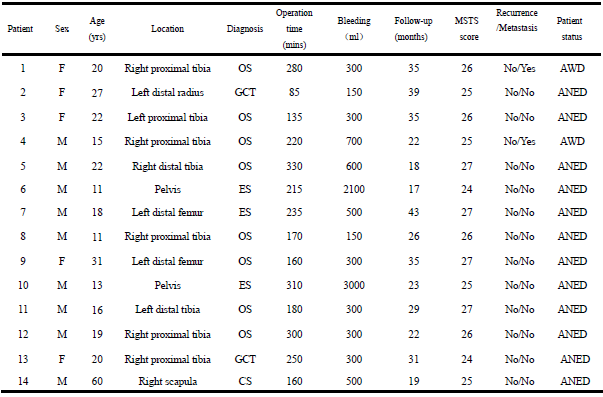
OS= osteosarcoma; GCT = giant cell tumor; ES = Ewing’s sarcoma; CS =chondrosarcoma; AWD = alive with disease; ANED = alive with no evidence ofdisease.
Treatment plan
Prior to surgery, X-ray, CT, magnetic resonanceimaging (MRI) and single-photon emission computedtomography/CT (SPECT/CT) scan were performed on all patients to determine the tumor border, tumor stage, and cuttingplane. We simulated osseous defect after tumor resection in computer andselected the most appropriate allograft after delicate matching process invirtual bone bank system as described above. Under virtual condition, the allograftwas simulated to be trimmed and fixed at the defect site on 3-D model. The safemargin, cutting plane, implant position, and screw sites could be designed and markedon 3-D model basing on surgical approach and exposure.
The CAOS (Stryker Pacific Ltd, HongKong, China) was used for precise excision and accurate reconstruction. For abetter show of tumor boundary, the CT, MRI and SPECT/CT images were imported and fusedin navigation system. The navigation-guided surgical resection was performed aspreviously reported [16]. After appropriateregistration and calibration, the surgeons located and marked the anatomicposition with K-wires using navigation tools for intended cutting plane. Then thetumor was removed en bloc with an oscillating saw. Eight samples from differentsides of removed tissue (proximal, distal, lateral, medial, up and down) weretaken, sectioned and stained to check whether a safe margin was achieved. Theallograft was cut and trimmed into the designed configuration to match the bonedefect with the help of navigation guide. Then it was implanted and fixed.
Follow-up and survival
Local recurrence, metastasis, functionalresults and complications were followed up every three months for three years,then every four to six months for the fourth year. The plain radiographs, chestCT scan, MRI and bone scintigraphy scan were used for follow-up purposes. Thefunctions were evaluated by the MSTS93 functional score and expressed as mean±SD [3].
Typical patients
Patient1
A 19-year-old male patient (Patient No.12)had developed right knee pain for 5 months. Radiological examinations showed amixed sclerotic and lytic lesion at the right upper tibia (Fig.3A-C). The biopsy revealed the diagnosis of osteosarcoma. Before operationall image date were imported into CAOS and surgical planning was made on 3-Dtumor model (Fig.3D-F). The tumor boundary and the cuttingplane were discerned. The appropriate allograft had been selected from thevisual bone bank after matching process and the cutting plane was marked. Thesurgical intervention could be simulated virtually (Fig.4). During operation, the tumor wasexcised strictly in line with the designed cutting plane using CAOS. Afterosteoectomy, the allograft was cut and trimmed with the help of navigationguidance (Fig.5A-B). Then it was fixed to the host bonewith a plate. After 6-month follow-up, the radiograph showed good bone healingand alignment (Fig.5C).
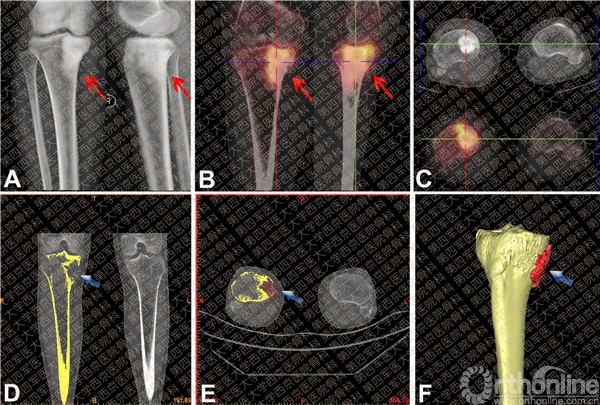
Figure3: A 19-year-old malepatient with osteosarcoma. (A) X-ray film showed a mixed sclerotic andlytic lesion at the right upper tibia; (B, C) Coronal and axial images of bonescintigraphy showed tumor lesion; (D, E) Coronal and axial images of CTscanning showed tumor lesion. The pseudo color was applied; (F) 3-D tumor model was reconstructed.(The arrows indicated tumor lesion)

Figure4: Surgical planning and allograft matching. (A) Tumor resection with safemargin in a virtual environment; (B) Illustration of
comparison between theresected bone and allograft from visual bone bank system;
(C) Illustration ofthe good fit of a part cut out from the best matching tibia and placed at thelocation of the resected section.
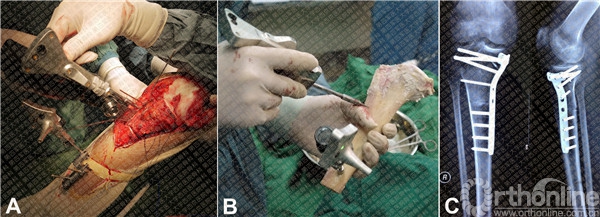
Figure5: (A) Tumor resectionstrictly in line with designed cutting plane with the help of CAOS; (B)Allograft was cut and trimmed using navigation guidance; (C) Radiograph showedgood bone healing and alignment at 6months postoperatively.
Patient2
An 11-year-old boy (Patient No.6) wasdiagnosed with Ewing’s sarcoma at the right acetabulum after biopsy.Radiological examination showed an osteolytic lesion involving right pubisand acetabulum (Fig.6). After the image data was imported into CAOS, the tumor boundary and the cutting plane werediscerned in reconstructed 3-D tumor model as described above (Fig.7A). With the intra-operative navigation ofCAOS, the tumor was precisely en block resected as designed preoperatively. Afterosteoectomy, the allograft was fixed to the rest pelvis using screw and plate. At6 months postoperatively, CT scan and 3-D reconstruction showed good bonehealing and congruent acetabular surface (Fig.7B,7C).
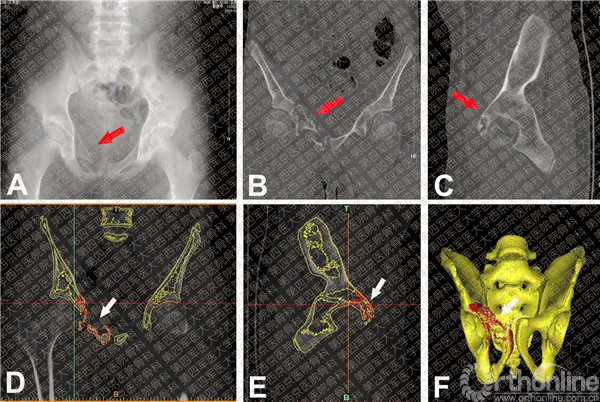
Figure6: An 11-year-old boy withpelvic Ewing’s sarcoma. (A) X-ray film showed an osteolytic lesion involving right pubis and acetabulum; (B, C) Coronal andsagittal images of CT scanning showed tumor lesion; (D, E) The pseudo color was applied incoronal and sagittal images of CT scanning. (F) Reconstruction of 3-D tumormodel. (The arrows indicated tumor lesion)
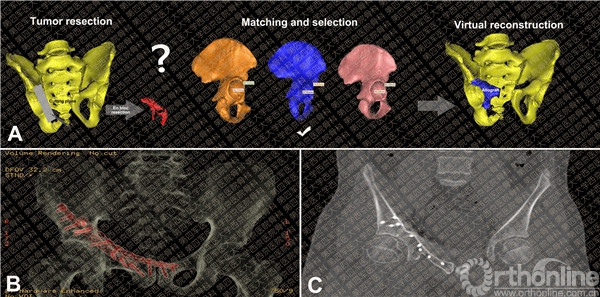
Figure7: (A) Tumor was resected with safe margin in a virtual environment; Good fitof a part was cut out from the best matching pelvis and placed at the locationof the resected section; (B, C) At 6months postoperatively, CT scan and 3-D reconstruction showed good bone healingand congruent acetabular surface.
Results
The average operation time was 216 minutes(ranging from 85 to 300 minutes) and average blood loss during surgery was 678ml (ranging from 150 ml to 3000 ml). There was no neurovascular bundle injuryoccurred during surgery. The follow-up time ranged from 17 to 43 months (median:27.5 months). Two patients with OS were found to have pulmonary metastasis at 5and 10 months postoperatively. After interventional radiotherapy for metastaticlesion, they were now alive with disease (AWD). No local recurrence or metastasiswas observed in rest patients. At the time of their last follow-up, 12 patientswere alive without evidence of disease (AWED). They had an average functionalscore of 25.7±1.1 points. X-ray film of follow-up showed the good bone healing.There was no joint narrowing, subchondral bone collapse, limb lengthdiscrepancy, and screw loosening in any of the patients (Fig.8A). In contrast, X-ray filmof implantation with manually selected allograft showed the delayed bonehealing and joint degeneration in one patient before establishment of 3-Dvisual bone bank system (Fig.8B).
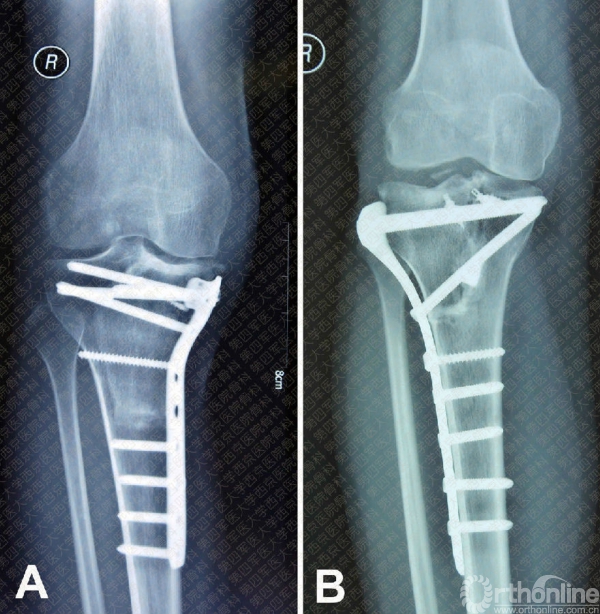
Figure8: (A) X-ray filmshowed the reconstruction with 3-D visual bone bank selected allograft inpatient with right proximal tibial osteosarcoma at 22 months postoperatively;(B) X-ray film showed the reconstruction with manually selected allograft inpatient with right proximal tibial giant cell tumor at 24 monthspostoperatively.
Discussion
In recent years, massive allograft transplantationhas become an accepted procedure to recovery the original anatomy in limbsalvage surgery. The major complications include infection, dislocation,nonunion, fracture, immunity rejection, and internal fixation failure [17, 18]. For allograft transplantation, themost appropriate allograft provides not only a holder with suitable strength,shape and size but also a good articular surface and attachment point ofmuscle, ligament, and joint capsule [19]. The establishment of modern bone bank ensures the superior quality andconsistent supply of allograft [7]. However, the accuracy of allograft placement, especially partialosteoarticular allograft, and selection methods are still challenging. The key liesin how to quickly screen and select the most appropriate allograft with similarmorphology.
With 3-D visual bone bank system, the appropriateselection could be achieved prior to surgery. The safety and effectiveness of thissystem was evaluated through application in 14 patients and showed promisingresults. The average MSTS functional score was 25.7±1.1 points, which wasconsistent with the other report [14]. There was no nonunion occurred in current series of 14 patients.Enneking et al[20] investigated the survival and complicationsof distal femoral osteoarticular allograft transplantation in 26 patients.Nonunion was occurred in 5 patients (19%) at 9-24 months postoperatively.Muscolo et al [13] reported that the nonunion rate was 6%in 58 allografts of 62 patients. Mnaymneh et al [21] reported that the nonunion rate was 12%in 83 allografts of 83 patients. Compared to other reports, the lower nonunion ratein current study could most likely be attributed to improved matching processand precise excision with CAOS. In addition, the small number of patients mightalso contribute to this discrepancy.
At present many conventional bone bankshave been established in China and continuous supply of allografts is ensured. Tomeet the requirement of matching, the china’s first visual bone bank was startedto set up in Xi-Jing hospital in 2010. After CT scanning, the 3-D informationof each allograft including length, width, height, and curve was saved in DICOMfiles. All DICOM files were imported into Mimics software to establish a visualbone bank system. This visual bone bank possessed the following features: (1)convenient management of bone bank; (2) accurate and easy matching ofallograft; (3) shortened the time needed for allograft cutting and trimming;and (4) precise reconstruction with the help of CAOS.
The volume-based registration was usedin this study. Bousleiman et al [14] compared three different existingmethods including manual selection, automatic volume-based registration, andautomatic surface-based registration. For all patients, the automatic methodsoutperformed the manual counterpart regarding to the matching parametersincluding the surface to surface distance and contact surface overlapping. Therewas no statistically significant difference between the two automaticalgorithms. Another report indicated that the volume-based registration wasmore accurate than surface- or point-based registration [22]. Therefore, volume-based registrationis a reliable method for allograft selection. In some surgical scenarios suchas epiphyseal, unicondylar and bicondylar resections, the allograft needs to becut and trimmed into irregular shape. Furthermore, the cartilagineous tissuehas to be considered. Because CT image does not provide adequate contrast insoft tissues, CT and MRI DICOM images were integrated in the navigation system.As different image datasets shared identical spatial coordinates after imagefusion, a 3-D bone tumor model was generated as reported by Wong et al. [23]. It usually offered high quality modelthat was adequate for allograft selection and further trimming.
Compared with operations basing onsurgeon’s experience, the method combining visual bone bank and CAOS techniquescould provide more real-time information on spatial position of anatomy sites,implants and surgical instruments for surgeons. Thus, the intra-operativefeedback was improved and exposure time to radiation was shortened [24, 25]. Follow-up results showed that thebones healed well and functions were good in this study. Only two patients werefound to have pulmonary metastasis at 5 and 10 monthspostoperatively. No localrecurrence or metastasis was observed in rest patients.
Our study had several limitations. Firstly,we didn’t have enough follow-up results of patients who received manually selectedallografts implantation at same anatomic sites as control. No data from ahistorical cohort of patients could be added. Therefore, this study just gavethe preliminary results of level IV (case series) study. Secondly, this studyshowed the middle-term follow-up results ranging from 17 to 43 months (median:27.5 months). Although the follow-up time was longer than those reported andpromising results were also achieved [14], much longer-term follow-up was still needed to further explore theimpact of this technique. Finally, operation time is influenced by many factorsincluding neurovascular bundle dissection, tumor resection, vascularanastomosis, and allograft cutting, trimming, and fixation. Allograft cuttingand trimming can partially affect the operation. The 3-D visual bone banksystem can theoretically shorten the operation time. However, there is nopublished data specifically focusing on the time used for allograft preparationtime during operation. The current study also lacks such data. In spite ofthese shortcomings, the current research still added further information on 3-Dvisual bone bank system based allograft selection.
In conclusion, volume-based registrationmethod was used for allograft selection from virtual bone bank system in thisstudy. The individual surgical planning was achieved with the help of CAOS. Thefollow-up results proved the safety and effectiveness of this technique.Although this single-center study was small in scale and the follow-up time wasshort, the results demonstrated the advantages of this technology. However,multi-center, random study will still be needed to verify the validity of thistechnique and to stronger conclusions in near future.
Acknowledgments
We acknowledged the assistance of Prof. LuisAponte Tinao (Ortopedia Oncologica, Hospital Italiano de Buenos Aires,Argentina) in visual bone bank setup and paper preparation.
Zhigang Wu,#Jun Fu,# Zhen Wang,Xiangdong Li,Jing Li,Yanjun Pei,Guoxian Pei, Dan Li, Zheng Guo*,Hongbin Fan*
Departmentof Orthopaedic Surgery, Xi-Jing Hospital, the Fourth Military MedicalUniversity,
.Authors’Contribution
# These authors contributed equallyto this work
*Correspondenceto:
ZhengGuo, MD, PhD, Department of Orthopaedic Surgery, Xi-Jing Hospital, the FourthMilitary Medical University, Xi’an, 710032, China. Tel: +86-29-84775284, Fax:+86-29-84771064, E-mail: guozheng@fmmu.edu.cn
HongbinFan, MD, PhD, Department of Orthopaedic Surgery, Xi-Jing Hospital, the FourthMilitary Medical University, Xi’an, 710032, China. Tel: +86-29-84773164, Fax:+86-29-84771064, E-mail: fanhb@fmmu.edu.cn
References
1. Campanacci D, Chacon S, Mondanelli N, BeltramiG, Scoccianti G, Caff G, Frenos F, Capanna R (2012). Pelvic massive allograftreconstruction after bone tumourresection. Int Orthop 36(12):2529-2536.
2. Makridis KG, Ahmad MA, Kanakaris NK,Fragkakis EM, Giannoudis PV (2012). Reconstruction of iliac crest with bovinecancellous allograft after bone graft harvest for symphysis pubis arthrodesis.Int Orthop 36(8):1701-1707.
2. Ritacco LE, Seiler C, Farfalli GL,Nolte L, Reyes M, Muscolo DL, Tinao LA (2013) Validity of an automatic measureprotocol in distal femur for allograft selection from a three-dimensionalvirtual bone bank system. Cell Tissue Bank 14:213-220.
3. Enneking WF, Dunham W, Gebhardt MC,Malawar M, Pritchard DJ (1993) A system for the functional evaluation ofreconstructive procedures after surgical treatment of tumors of themusculoskeletal system. Clin Orthop Relat Res 286:241-246.
5.Kong CG, Kim YY, Park JB (2012).Postoperative changes of early-phase inflammatory indices after uncomplicatedanterior cervical discectomy and fusion using allograft and demineralised bonematrix. Int Orthop 36(11):2293-2297.
6. Santic V, Tudor A, Sestan B, LegovicD, Sirola L, Rakovac I (2010). Bone allograft provides bone healing in themedial opening high tibial osteotomy. Int Orthop 34(2):225-229.
7. Matejovsky Z Jr, Matejovsky Z,Kofranek I (2006) Massive allografts in tumour surgery. Int Orthop 30:478-483.
8. Ramseier LE, Malinin TI, Temple HT,Mnaymneh WA, Exner GU (2006) Allograft reconstruction for bone sarcoma of thetibia in the growing child. J Bone Joint Surg Br 88:95-99.
9. Muscolo DL, Ayerza MA, Aponte-TinaoLA, Ranalletta M (2005) Partial epiphyseal preservation and intercalaryallograft reconstruction in high-grade metaphyseal osteosarcoma of the knee. JBone Joint Surg Am 87 Suppl 1(Pt 2):226-236.
10. Muscolo DL, Ayerza MA, Aponte TinaoLA, Ranalletta M (2004) Distal femur osteoarticular allograft reconstructionafter grade III open fractures in pediatric patients. J Orthop Trauma 18:312-315.
11. Muscolo DL, Ayerza MA, Aponte-TinaoLA (2000) Survivorship and radiographic analysis of knee osteoarticularallografts. Clin Orthop Relat Res (373):73-79.
12. Paul L, Docquier PL, Cartiaux O,Cornu O, Delloye C, Banse X (2008). Inaccuracy in selection of massive boneallograft using template comparison method. Cell Tissue Bank 9:83-90.
13. Muscolo DL, Ayerza MA, Aponte-TinaoLA, Ranalletta M (2006) Use of distal femoral osteoarticular allografts in limbsalvage surgery. Surgical technique. J Bone Joint Surg Am 88 Suppl 1 Pt 2:305-321.
14. Ritacco LE, Farfalli GL, Milano FE,Ayerza MA, Muscolo DL, Aponte-Tinao L (2013) Three-dimensional virtual bonebank system workflow for structural bone allograft selection: a technicalreport. Sarcoma 2013:524395.
15. Bousleiman H, Paul L, Nolte LP,Reyes M (2013) Comparative evaluation of pelvic allograft selection methods.Ann Biomed Eng 41:931-938.
16. Fan H, Guo Z, Wang Z, Li J, Li X(2012) Surgical technique: Unicondylar osteoallograft prosthesis composite intumor limb salvage surgery. Clin Orthop Relat Res 470:3577-3586.
17. Nakazawa T, Takaso M, Imura T,Adachi K, Fukushima K, Saito W, Miyajima G,Minatani A, Shinntani R, Itoman M,Takahashi K, Yamazaki M, Ohtori S, Sasaki A (2010). Autogenous iliac crest bonegraft versus banked allograft bone in scoliosis surgery in patients withDuchenne muscular dystrophy. Int Orthop 34(6):855-861.
18. Francés A, Moro E, Cebrian JL, MarcoF, García-López A, Serfaty D, López-Durán L (2007). Reconstruction of bonedefects with impacted allograft in femoral stem revision surgery. Int Orthop 31(4):457-464.
19. Jensen TB, Rahbek O, Overgaard S,Søballe K (2005). No effect of platelet-rich plasma with frozen or processedbone allograft around noncemented implants. Int Orthop 29(2):67-72.
20. Toy PC, White JR, Scarborough MT, EnnekingWF, Gibbs CP (2010) Distal femoral osteoarticular allografts: long-termsurvival, but frequent complications. Clin Orthop Relat Res 468:2914-2923.
21. Mnaymneh W, Malinin TI, Lackman RD, HornicekFJ, Ghandur-Mnaymneh L (1994). Massive distal femoral osteoarticular allograftsafter resection of bone tumors. Clin Orthop Relat Res 303:103-115.
22. West J, Fitzpatrick JM, Wang MY, DawantBM, Maurer CR Jr, Kessler RM, Maciunas RJ (1999). Retrospective intermodalityregistration techniques for images of the head: surface-based versusvolume-based. IEEE Trans Med Imaging 18:144-150
23. Wong KC, Kumta SM, Chiu KH, AntonioGE, Unwin P, Leung KS (2007) Precision tumour resection and reconstructionusing image-guided computer navigation. J Bone Joint Surg Br 89:943-7.
24.Viceconti M, Lattanzi R, Antonietti B, Paderni S, Olmi R, Sudanese A, Toni A (2003) CT-based surgical planningsoftware improves the accuracy of total hip replacement preoperative planning.Med Eng Phys 25:371-377.
25. Meyer U, Wiesmann HP, Runte C, Fillies T, Meier N, Lueth T, Joos U (2003) Evaluation of accuracy of insertion ofdental implants and prosthetic treatment by computer-aided navigation inminipigs. Br J Oral Maxillofac Surg 41:102-108.





 京公网安备11010502051256号
京公网安备11010502051256号